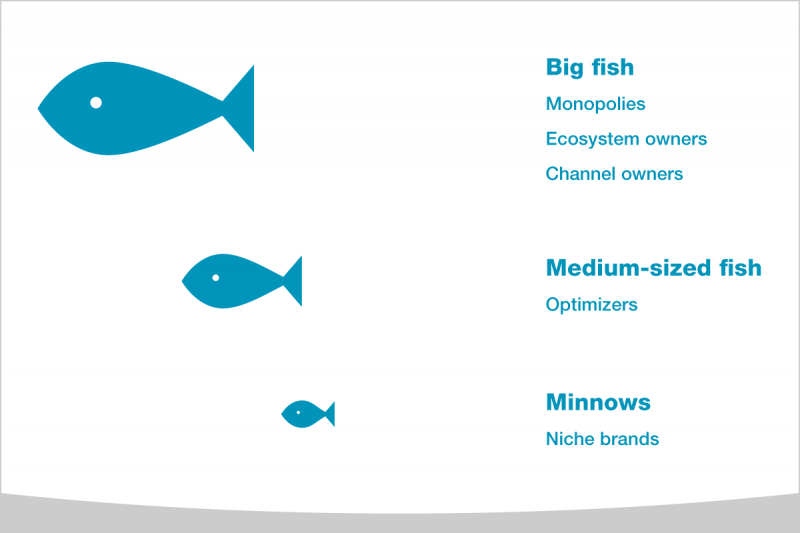Long ago a colleague recommended that I read the book Eating the Big Fish by Adam Morgan. I did. At the time, I thought it was interesting, if simplistic. And then I continued to use it as a key tool in my professional work for the next dozen years.
The core idea in Eating the Big Fish is that there are large incumbents in every market space, but “little fish” can come to dominate the ecosystem through effective brand-building and communication. The book came out at a time when “brand” was the buzziest of buzzwords, one that could smother any attempt at critical thinking. Yet the book has endured as a modern business classic.
Eating the Big Fish starts with the thesis that in every competitive environment there are two leaders: a market leader and a thought leader. The thought leader—aka the “challenger brand”—must do several things to create awareness and pull attention away from the market leader:
- Break with the immediate past.
- Build a “lighthouse identity.” Stand for clear and different ideas,
communicated loudly. - Reframe the conversation.
- Create symbols of re-evaluation.
There’s perhaps a mixed metaphor here, with small fish building lighthouses (underwater?), but I’ll forgive it. This is a really good list. And its logic makes sense: if you’re not the leader yet, you must create a unique, compelling, and highly visible presence. Otherwise, no one will be able to remember you or understand why your offering is better.
As I said, over the past decade or so, I have found myself often returning to this idea of the challenger brand, and using it with a wide range of clients. The wisdom of Eating the Big Fish appears to be broadly useful. But why would that be?
I think the reason the book remains relevant, and broadly so, is that its narrow focus obscures a deeper insight about our current economy and media ecology:
Every brand communicates as if they are #1 in their respective space.
To explain why this might be, I want to share an adapted version of the Eat Big Fish framework that retains its original metaphor, but extends it to make a few additional points.
In every “space,” we find:
- A monopoly or ecosystem owner
- Optimizers within that ecosystem
- Niche brands who are only going after a small part of the overall opportunity
Each of these levels has an objective leader who owns the largest share of the overall market. All these leaders are #1.
Each of these levels also has a primary market challenger, a disruptor who is trying to change the terms of the overall space. Like the market leaders, these challenger brands are also #1… in leading the new categories that they themselves are defining.
This crude breakdown gives you a sense of why every organization positions itself as #1. It’s not that they’re all lying—it’s that, in a way, they are telling the truth. They are each excelling at the unique thing they are trying to do. And Jack Welsh’s famous notion, when not taken to extremes, remains correct: if you can’t be #1 (the market leader) or #2 (the thought leader) in your core category, you do not have a future.
If you’ve been in business long enough, you begin to understand that being the challenger—the category disruptor—is the only way for the mid-sized and bigger fish to survive and thrive over the long haul. Companies die quickly or slowly when they optimize within the parameters of their existing space. They run out of room to grow. Geoffrey West has written about this poignantly, and it’s one of the reasons companies like Amazon, Nike, Facebook, Google, Apple, and Tesla are always signaling that they are, in Jeff Bezos’s words, “Day 1” companies. Permanent disruptors.
The corollary is that every organization finds based on its environment that it must become either a small, niche success or a “challenger brand.”
So… the reason every brand communicates as if they’re number one is not that they’re blind, smug, stupid, dishonest, or lucky.
It’s because—they have to.
